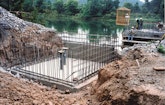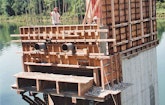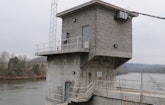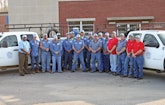
Interested in Location/Detection?
Get Location/Detection articles, news and videos right in your inbox! Sign up now.
Location/Detection + Get AlertsA firm handshake and concern for the customer were as important as backhoes and budgets to the success of a $16 million water project in Livingston, Tenn.
A new 19-mile water intake line from the Cumberland River to the town’s water treatment plant went through hayfields and across the driveways of dozens of rural residents who weren’t very happy with the project at first.
But the sincerity of water systems manager Tim Coffee, and a willingness to make adjustments to the route in response to property owners’ concerns, won the day — and without any messy condemnation procedures.
“We were called names, and there were threats, but we looked people in the eye and promised we wouldn’t leave them with a bad job,” recalls Coffee. “Our contractors did a great job.
“Today,” he says of the property owners, “I count these folks as good friends.”
The Livingston project, completed in 2009, was necessitated by recurring droughts and water shortages in this hilly community of 20,000 people midway between Nashville and Knoxville.
Previously, Livingston drew its water from a shallow 54-acre impoundment behind a local dam.
“We nearly ran out of water several times,” recalls Coffee, who’s been with the utility for 27 years. “We had to shut down car washes; people couldn’t fill their swimming pools.”
He says the leadership of Livingston Mayor Curtis Hayes — then on the city council — pushed the town to develop a more reliable source and build the necessary infrastructure.
“We were tired of the situation,” Coffee says. “Mayor Hayes convinced us to seek a better solution.”
The project
The Livingston waterline was no ordinary project. At first, the town looked to nearby Dale Hollow Lake as a water source, but withdrawal fees that would have been imposed by the Army Corps of Engineers were out of Livingston’s price range.
The next best choice was the Cumberland River, which could be tapped without fees but was nearly 20 miles from the utility’s water treatment plant. Plus, the route ran over hilly terrain and would require high-pressure pumping.
The river intake structure itself presented another challenge. Its location is downstream of the Wolf Creek Dam, which is undergoing extensive repairs. To withstand the possibility of dam failure, the structure had to be anchored to the rock bottom of the river by steel rods grouted into 3-inch-diameter, 9-foot-deep borings.
“It was not cost-effective to raise the electrical systems (supplied by Eaton) the 19-20 feet required to protect them against potential flood levels,” explains the town’s engineer, Roy Wauford of J.R. Wauford & Co., Nashville. “But the structure is designed so it will withstand a dam failure if one ever occurs.”
The intake structure also features intake gates at two levels to allow selection of the best water quality.
Transporting water over long distances at higher than normal pressures may be common in the West, but it’s unusual in Tennessee. “As far as we know,” Wauford says, “there is no system other than Livingston in the Southeastern U.S. transporting water over a like distance with similar pressures.”
A pair of high-pressure pumps from Flowserve do the job. The pumps are rated at 500 and 700 psi, respectively, and provide the 310 psi working pressure necessary to move the water from the intake structure some 50,000 feet to a surge tank located on a high ridge halfway to the treatment plant. Slow-closing, oil-actuated ball valves and specially made butterfly relief valves from the Henry Pratt Co. control the flow, minimize surges and prevent water column separation.
Except when the new waterline went under roadways, contractors used open trench construction to lay 20-inch ductile iron pipe varying from special thickness Class 52 (for 500 psi) down to Class 250. Average trench depth was five feet, and at least 42 inches of soil covers all cuts. The line had to run up and down hillsides with grades as much as 40 degrees. From the river to the ridgeline, elevation rises nearly 650 feet. And with the 54-foot side water depth of the surge tank, static head is 700 feet.
Coffee recalls watching contractors loading pipe onto a sled and winching it up the hill. “Some days we’d barely lay 20 feet (of pipe),” he says. “At one point, we had to dynamite a hillside.” The line also had to cross under a creek bed five times on its way up to the surge tank. Under these conditions, bends were limited to 45 degrees and required the use of specially designed, reinforced concrete thrust blocks.
The surge tank has a capacity of about 300,000 gallons, and water flows by gravity through C905 PVC pipe — also installed via open trench methods — another 50,000 feet to the Livingston Water Treatment Plant. The arrangement enables operators to regulate the flow through the plant regardless of the raw water being pumped, and also allows the plant to continue to produce water during power outages.
Treatment plant
Last expanded in 2006, the water plant now has a capacity of 4 million gallons a day and features pre- and post-chlorination, conventional flash mixing and flocculation, and high-rate sand and anthracite bed filtration.
Supervisor Johnny White, who has logged 39 years of experience at the facility, explains that activated carbon is used to improve taste and odor, and that a seven-chain phosphate is added to the clearwell to inhibit corrosion and scale. He reports that flow averages about 2.3 mgd in the winter, and 2.5 to 3.0 mgd during the summer. The plant also adds fluoride to the product water. High-pressure pumps push the product water to the distribution system.
In order to monitor and control the new water system, an extensive supervisory control and data acquisition (SCADA) system was designed and installed by Southern Flow of Atlanta, Ga. The system uses solar panels where power is not available, and to solve any line-of-sight problems, a 60- foot-high antenna on the top deck of the raw water intake transmits data to a central data acquisition point at the highest elevation in the system.
The system also controls the treatment plant operation, monitoring the filters and exhibiting tank levels around the system in real time. Coffee says the SCADA system is “the biggest blessing we’ve ever had.”
Dead ends
Treated water is distributed to Livingston’s customers through a far-flung network of waterlines and storage tanks. Dead ends are common. Coffee explains that many of the lines go into remote areas and serve only one or two homes.
“You’ll be driving out in the country and you wouldn’t believe there’s a water line out there, but there is,” he says.
Some of these outlying lines were established by small, separate utility districts before the town took them over. The system has 105 dead ends, according to Coffee, and that can lead to problems with flushing and maintaining the water supply and chlorine residual.
“It can be a nightmare,” he says. “We flush every three months, or as needed.”
Yet, none of these issues, including fixing leaks and rebuilding meters (see sidebar) amount to much when compared with the task of getting the 90 or so private property easements required to facilitate the intake line project in the first place.
“A lot of these people had nothing to gain from the new line,” says Coffee. “Some of them were getting their water from another system, yet we had to go across their property.”
Coffee attributes much of the success to plain old face-to-face honesty.
“My grandfather taught me the importance of your handshake,” Coffee says. “We never went onto somebody’s land without asking first. We never drove over people’s property. We looked them in the eye and didn’t lie to them. Now, nobody has come back to us and said we did them wrong. That’s a good feeling.”
Working with Melissa Boner from J.R. Wauford and city attorney Kelly Williams, Coffee was able to negotiate all the easements in a year and a half. He credits the project contractors for cementing the relationships with good performance.
“They made the situation possible,” he says. “It was just the way they worked with people … they treated the hayfields or driveways like their own … they filled holes quickly and if they had to cut down trees, they piled the logs up neatly for the property owner to use.”
Coffee says many times, the easement was carved out along property edges and fence lines rather than going through the middle. “It was more costly,” he says, “but it made people happy and created less resistance.
“Any little thing that was necessary to make it happen, we did that.”
In a compliment to Coffee and the utility, Wauford says, “We never did a project of this size without having to go to court.”
Payoff
Bringing a reliable supply of freshwater to the Town of Livingston has required a lot of hard work and persistence over several years, but today, the effort is paying off.
The town won a prestigious award from the Tennessee Municipal League last year (see sidebar) and is earning high marks from state regulators.
“They do a survey every two years,” Coffee explains. “They check everything — flushing records, cross connections, tapping, leaks, chlorine residuals, flow rates, computer records. We scored 597 out of 599 possible points — or 99 percent.”
And while it’s true that the project has forced Livingston’s user rates to go higher, Coffee believes the investment is worthwhile.
“Our water may be more expensive than that of other utilities, but we’ve bitten the bullet,” he says. “There are other towns near us that still don’t have a permanent water source. Now, they’re looking to buy water from us. We feel we’re ahead of the game.”












